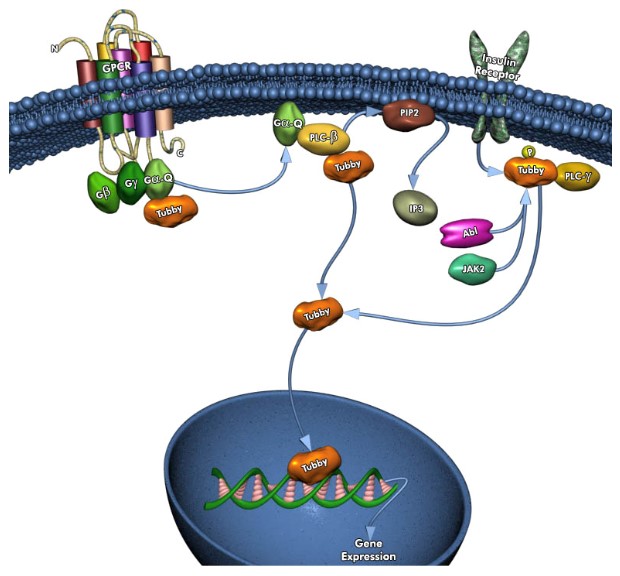Mempro™ Cell-Based Transcriptional Factor Tubby Production
Creative Biostructure assures the best services for high-quality transcriptional factor tubby production since we have an experienced scientific team and an advanced and comprehensive Mempro™ cell-based membrane protein production platform.
There is a kind of proteins named transcription factor that can bind to specific DNA sequences in molecular biology. Transcription factor controls the genetic information transcription rate from DNA to messenger RNA. Tubby protein is one of the transcription factors which is encoded by the TUB gene. Proteins which are homologous to tubby protein share a similar tertiary structure. In their central pore, there is a beta barrel tightly packed around an alpha helix. Tubby proteins are able to bind to phosphatidylinositol which is typically thought to be a small signaling molecule localized to the membrane. Tubby proteins have been also regarded as potential signaling factors which are involved in G-protein activity. Tubby proteins have been identified in association with neuronal differentiation and development. Some mutations of tubby protein will result in three diseases: retinal degeneration, obesity, and hearing loss.
 Figure 1. G-protein signaling regulated by tubby protein.
Figure 1. G-protein signaling regulated by tubby protein.
Creative Biostructure is concentrated on providing the first-class membrane proteins production services, we are able to apply various strategies to produce transcriptional factor tubby by our Mempro™ cell-based systems, including:
• Mempro™ Transcriptional Factor Tubby Production in Bacterial Cells System
Escherichia coli (E. coli) is the most popular bacterial host to produce membrane proteins, providing multiple options to optimize the production protocols. Generally, there are two strategies for E. coli membrane protein production system, one is insertion of the soluble membrane protein into the cellular membrane, the other is cytoplasmic aggregation as inclusion bodies (IBs).
• Mempro™ Transcriptional Factor Tubby Production in Insect Cells System
With years of efforts by our research team, we have well established the Mempro™ insect cells system for expression target membrane proteins. The baculovirus expression vector system is a versatile and powerful system to produce high-quality membrane proteins. Mempro™ insect cells system can not only improve the solubility but also deliver a higher yield of membrane proteins.
• Mempro™ Transcriptional Factor Tubby Production using Mammalian Cells System
Creative Biostructure can provide Mempro™ protein production in mammalian cells system. This system facilitates membrane proteins to form correct conformation and post-translational modification.
• Mempro™ Transcriptional Factor Tubby Production in Yeast Cells System
Single-celled yeast as the culture host for membrane protein production has advantages such as easy, quick and cheap. Creative Biostructure has developed several strategies to improve production yields by optimizing the expression plasmid, host cell and culture conditions.
Creative Biostructure delivers the high-yield transcriptional factor tubby production by Mempro™ cell-based protein production services including expression, isolation, purification and crystallization.
We provide different strategies for Mempro™ membrane protein production services. Please feel free to contact us for a detailed quote.
References:
D. F. Voytas and J. K. Joung. ( 2009). Plant science. DNA binding made easy. Science, 326(5959): 1491–1492.
J. A. Copland, et al. (2009). Sex steroid receptors in skeletal differentiation and epithelial neoplasia: is tissue-specific intervention possible? BioEssays, 31(6): 629–641.
A. Bateman, et al. (2009). Phospholipid scramblases and Tubby-like proteins belong to a new superfamily of membrane tethered transcription factors. Bioinformatics, 25(2): 159–162.
K. Carroll, et al. (2004). Tubby proteins: the plot thickens. Nat. Rev. Mol. Cell Biol., 5(1): 55–63.